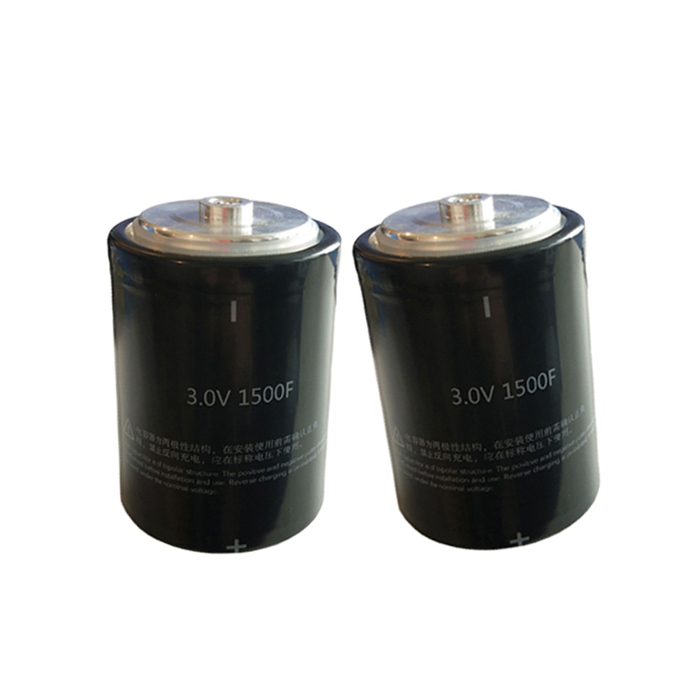Consulting phone:
135-3037-2041
(Mr.Wang)
Guide:Farad capacitors are mainly composed of polarized electrodes, collectors, electrolytes, diaphragms, leads and packaging materials. The electrode material, the composition of the electrolyte, the quality of the separator and the electrode manufacturing technology have a decisive influence on the performance of the Farad capacitor.
Farad capacitors are capacitors that use the electric double layer principle . When the applied voltage is applied to the two plates of the Farad capacitor, it is the same as the general capacitor, the positive electrode of the plate stores positive charge, and the negative plate stores negative charge. Opposite charges are formed on the interface between the electrolyte and the electrode to balance the internal electric field of the electrolyte. The positive and negative charges are arranged in a very short gap between the positive and negative charges on the touch surface between the two different phases. In the opposite position, this charge distribution layer is called the electric double layer, so the capacitance is very large.

When the potential between the two plates is lower than the redox electrode potential of the electrolyte, the charge on the electrolyte interface will not be separated from the electrolyte, and the Farad capacitor is in a normal working state (generally below 3V). If the voltage across the capacitor exceeds the oxidation of the electrolyte When the electrode potential is reduced, the electrolyte will decompose and become abnormal. Because with the discharge of the Farad capacitor, the charges on the positive and negative plates are discharged by the external circuit, and the charge response on the interface of the electrolyte is reduced. From this, it can be seen that the charging and discharging process of Farad capacitors is always a physical process, and there is no chemical reaction. Therefore, the performance is stable, which is different from batteries that use chemical reactions.
First, the characteristics of Farad capacitors
(1) The charging speed is fast, charging for 10 seconds to 10 minutes can reach more than 95% of its rated capacity;
(2) The cycle life is long, the number of deep charge and discharge cycles can reach 10,000 to 500,000 times, there is no "memory effect", and there is no problem of excessive discharge;
(3) The high-current discharge capacity is super strong, the energy conversion efficiency is high, the process loss is small, and the high-current energy cycle efficiency is greater than or equal to 90%;
(4) The power density is relatively low, about 300W/KG~5000W/KG, which is only equivalent to 1/5~1/10 of the lithium battery;
(5) The composition, production, use, storage and dismantling process of the raw materials of the product are all pollution-free, and it is an ideal green power source;
(6) The charging circuit is simple, no charging circuit like a rechargeable battery is needed, and long-term use is free of protection;
(7) Good ultra-low temperature characteristics, wide temperature range -40℃~+70℃;
(8) The detection is convenient, and the remaining power can be directly read out;
(9) The capacity range is generally 0.01F--1000F, and the withstand voltage is often low (a few volts to more than ten volts, and the newly announced ones are only more than twenty volts).
supercapacitors _Super capacitor module , suitable for high-capacity needs.
2. Long service life of Farad capacitors
Farad capacitors are different from ordinary batteries. It is an electrochemical element, and no chemical reaction occurs during its storage process. Farad capacitors can reach farad-level capacity in a small volume without special charging and Discharge is a green and environmentally friendly product. Compared with batteries, farad capacitors can transmit energy repeatedly without reducing the service life like ordinary batteries. Farad capacitors have a relatively long life and charge and discharge times are 500 times that of pass-through batteries. Recycling is strong. Farad capacitors have no harmful chemicals, no pollution, and protect the environment. Suitable for export enterprises.
The withstand voltage of supercapacitors is low, generally only 2.5V, and the allowable surge voltage is 2.7V. Therefore, for a single supercapacitor, the maximum output voltage of the charger cannot exceed 2.7V, and only the operating voltage of the supercapacitor is required. Within the safe voltage, the service life of supercapacitors is very long, and the number of cycles of charge and discharge can reach 100,000 to 500,000 times.
It is precisely because the operating voltage of supercapacitors is low that it is often necessary to use several supercapacitors in series to increase the operating voltage. Because of the unbalanced nature of supercapacitors, it must be ensured that the charging voltage of any supercapacitor shall not be higher than 2.5 when used in series. V, the solution is to use a battery equalizer.
Farad capacitors have two main purposes: the use of high-power pulses and the maintenance of instantaneous power. Advantages of high-power pulse use: more power flows to the load in a short period of time; advantages of instantaneous power protection use: It is required to continuously increase the power of the load, and the persistence time is generally ten seconds or a few minutes. A fundamental use of short-term power retention is the reset of the disk drive head during power outages. Different machines have different parameter requirements for Farad capacitors. The use of high-power pulses is to use the small internal resistance of the Farad capacitor, while the short-term power persistence is to use the large electrostatic capacity of the supercapacitor.
The power density of supercapacitors is dozens of times that of ordinary lithium batteries, and the circuit requirements for charging are not high, saving charging and discharging time. Supercapacitors can be charged and discharged more than 500,000 times. If they are charged and discharged 20 times a day, they can be used continuously for 68 years. The service life is greatly extended. In addition, supercapacitors can be connected in series to form a capacitor bank, which can increase the storage capacity.